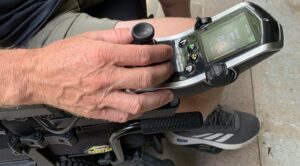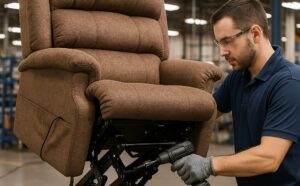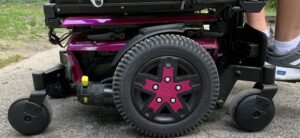How Digital Transformation Empowers Quality, Traceability, and Compliance for Wheelchair, Scooter, and Other Medical Device Manufacturers
In the world of mobility medical devices, manufacturers face the dual challenge of delivering innovative products—like power wheelchairs, scooters, and lift chairs—while navigating a labyrinth of regulatory requirements.
Compliance with standards such as the FDA’s Quality System Regulation (QSR) is not merely a legal obligation; it is also essential for patient safety, product reliability, and business success.
For many companies, digitizing assembly and manufacturing processes is no longer a luxury—it’s a strategic imperative.
But what does “digitizing manufacturing” truly mean for mobility medical device manufacturers, and how does it tangibly support regulatory compliance? Let’s explore the transformative potential of digital solutions, with a spotlight on real results.
The Regulatory Landscape: Complexity and High Stakes
Mobility medical devices are subject to stringent regulatory oversight. Agencies like the U.S. Food and Drug Administration (FDA) require manufacturers to adhere to rigorous quality assurance protocols, maintain detailed production records, and demonstrate traceability across the entire product lifecycle. Any lapse—notably in the context of adverse event reporting—can have severe consequences, including recalls or legal liability.
Products such as power wheelchairs and scooters typically offer a high degree of customization. Variations may include different leg lifts, reclining mechanisms, joystick configurations, head paddles, sip-and-puff controls, and more. Each configuration introduces more complexity—and a greater risk of error.
The Promise of Digitization for Regulatory Compliance
Digitizing assembly and manufacturing processes brings numerous advantages that directly align with regulatory requirements. Key benefits include:
- Enhanced Traceability: Every device receives a digital footprint or digital thread, recording exactly how it was assembled, which components were used, and who performed each operation. This is vital for root cause analysis in the event of a defect or recall.
- Validation and Testing: Digitize validation and testing procedures, data capture, and data storage including stability, durability, battery performance, speed and acceleration testing, and more. Digital assembly and manufacturing solutions can connect to test equipment and manage test processes for custom product configurations. Additionally, manufacturers can record information such as battery life date for a finished product and trigger notifications such as an end-of-life notification to the customer.
- Error-Proofing and Standardized Workflows: Digital work instructions help ensure that every operator, regardless of experience, performs tasks the correct way every time, regardless of the complexity or variability of products. Expert error-proofing such as pick to light and torque tool monitoring and control further reduce operator mistakes.
- Real-Time Quality Monitoring: Automated quality checks and data capture at every step enable manufacturers to prevent and catch errors early, reducing waste and rework.
- Simplified Compliance Reporting: Digital records make it easy to compile and submit documentation for regulatory audits, adverse event reporting, and corrective and preventive action (CAPA) investigations.
- Improved Training and High Operator Turnover Management: Digital systems deliver step-by-step guidance, making onboarding new operators faster and more reliable.
- Efficient Multi-Line Consistency: Complex facilities running parallel assembly lines (or parallel sections within a single line) can mirror processes, ensuring each product meets the same standards and regulatory expectations.
- Secure, Paperless Data Management: Electronic Device History Records (eDHRs) replace error-prone paper files, improving accessibility, security, and environmental sustainability.
- Purpose-Printed Labels and User Documentation: Digital systems manage custom, on-demand printing of labels including GTIN and documentation for each order, matching the specific configuration of the finished product. This on-demand process can reduce costs and inventory, accelerate throughput, and deliver compliance by ensuring manufacturers meet custom-configuration label and documentation regulations.
- Flexibility and Agility: Adjust manufacturing as needed more easily with a flexible digital manufacturing environment. You can respond to changing regulations with greater agility and ensure you’re meeting Medicaid and Medicare requirements for smoother invoicing and payment.
Invacare America worked with Matrix Automation to improve quality and throughput, meet regulatory requirements, and decrease errors to nearly zero. Explore the Invacare America case study.
Digital Transformation in Action
As an experienced solution provider for mobility medical device manufacturers, Matrix Automation exemplifies how digitization can revolutionize compliance. Let’s examine key features and benefits, using real-world examples:
1. Assembly Process Digitization and Error-Proofing
Wheelchairs, power wheelchairs, scooters, and lift chairs are just some of the highly variable and customizable products. Matrix digitizes quality checks right at the assembly station, dynamically adapting the checklist based on the specific order and its unique configuration. Operators are guided through step-by-step digital work instructions tailored to the precise model and selected options—whether it’s a special leg lift, custom joystick, attendant controls, or advanced sip-and-puff systems.

For instance, if a particular wheelchair requires programming a maximum speed for safety compliance, Matrix verifies and records that the correct parameters are programmed and validated before the device advances to the next production stage. This robust error-proofing reduces costly and dangerous mistakes, supporting both product safety and regulatory requirements.
2. Electronic Device History Record (eDHR) Management
For certain medical device classes, FDA regulations demand that manufacturers capture and store comprehensive assembly data for each device, including serial numbers and every step performed on the production line. Matrix can store this information digitally—no more printing and storing reams of paper. Every product shipped can have a full record, including photographs taken at quality checkpoints, ensuring indisputable evidence of build quality and compliance.
Pride Mobility worked with Matrix Automation to optimize their production lines at global manufacturing facilities. The Matrix solution digitizes engineering change management and compliance including FDA-regulated Device History Records. Learn more in the Pride Mobility case study.
If a problem surfaces—like a malfunctioning joystick—Matrix enables investigators to instantly review the complete digital history, seeing what parameters were programmed, who performed the work, and whether the device was properly released. This accelerates investigations and supports fast, data-driven CAPA.
3. Facilitating Proactive Quality Management
Matrix makes it straightforward for manufacturers to demonstrate FDA QSR compliance and can provide instant access to:
- Production facility and process descriptions
- Quality control procedures
- Material and parts usage
- Digitized employee processes including training and operator actions
During audits or adverse event investigations, the manufacturer can rapidly retrieve and present relevant data, significantly reducing stress and risk of noncompliance.
4. Training and Operator Support in High-Turnover Environments
Manufacturing floor turnover rates are notoriously high. Matrix addresses this by feeding information to operators, “step by step,” via digital displays at the assembly station. Every step—customized to the exact product configuration—is explained and confirmed before the operator proceeds. This not only can help ensure compliance but also boosts productivity and confidence among new hires.

5. Standardized, Orchestrated Work Instructions Across Parallel Lines
Mobility medical device manufacturers often run multiple assembly lines in parallel to meet demand. With potentially hundreds of unique processes on a line, ensuring consistency is critical.
Matrix’s solution allows operators and supervisors to verify that stations and lines mirror each other and are performing identically. The system can flag discrepancies, prompt corrective action, and confirm a match after changes—so whether building ten or a hundred medical devices, compliance and quality can remain uncompromised.
6. Comprehensive Data for CAPA and Adverse Event Reporting
When adverse events or quality issues arise, swift and thorough investigation is required. Matrix equips manufacturers with critical digital data to support root cause analysis and regulatory reporting. With actions, parameters, and quality checks logged in the system, compiling the information needed for CAPA documentation or FDA submissions can be routine rather than a scramble.
7. Deviation Approval and Management
When a required part is unavailable during assembly, Matrix streamlines the deviation process for medical mobility manufacturers. Operators can access a pre-approved list of alternate parts and, if necessary, initiate a new deviation request directly to the Quality team. This workflow is automatically managed within the Matrix solution, helping to ensure that all necessary approvals, communications, and actions across relevant teams are tracked in real time.
Once an operator performs a deviation—such as assembling a wheelchair with an alternative part, the steps are digitally recorded. This traceability ensures that the deviation is incorporated into the Electronic Device History Record (eDHR) for the finished product, supporting compliance and enabling thorough review in future audits or investigations.
How Digitization and Error-Proofing Support Regulatory Compliance
- Automated data capture for each assembly step can ensure full traceability and support audit readiness.
- Customizable digital work instructions can enforce correct procedures and reduce human error.
- Real-time photo documentation at quality checkpoints can provide visual proof of compliance.
- Parameter verification by the system (e.g., speed limits on wheelchairs) can prevent noncompliant devices from leaving the line.
- Orchestration tools can ensure that multiple lines or stations operate with identical standards and procedures.
- Electronic Device History Record (eDHR) storage can enable easy recall, reporting, and investigation.
- Integrated quality management data supports FDA QSR documentation requirements.
- Stepwise operator guidance speeds onboarding and mitigates risks of high turnover.
- Scalable error-proofing for complex, highly customizable devices like wheelchairs and scooters help prevent mistakes.
- Simplified CAPA and adverse event reporting via comprehensive digital records can ease compliance.
Digitization as a Compliance Catalyst
In the mobility medical device market, regulatory compliance is both a hurdle and an opportunity.
Digitizing manufacturing—through experienced solution partners such as Matrix Automation—not only eases the regulatory burden but also delivers higher-quality products, greater operational efficiency, and unmatched traceability.
For manufacturers of power wheelchairs, scooters, lift chairs, and similar devices, embracing digital transformation is the best way to help ensure every product that rolls off the line is safe, compliant, and ready to empower its next rider.
Ready to explore how Matrix Automation can bring digital transformation to your medical device manufacturing? Learn more here or contact us for a manufacturing assessment.



